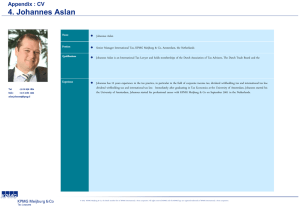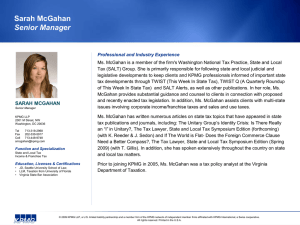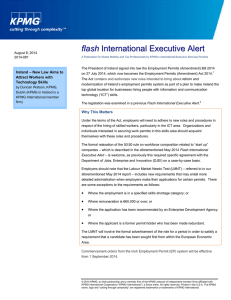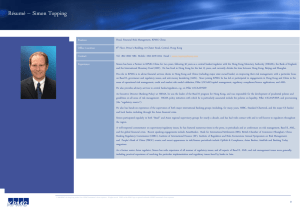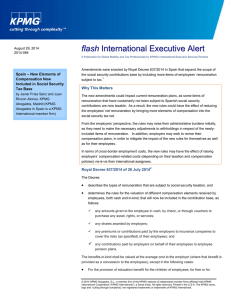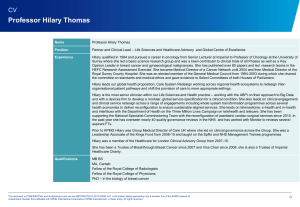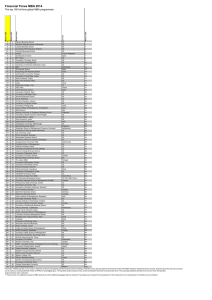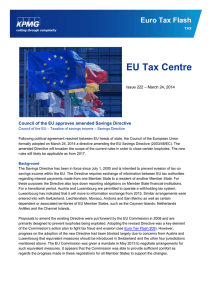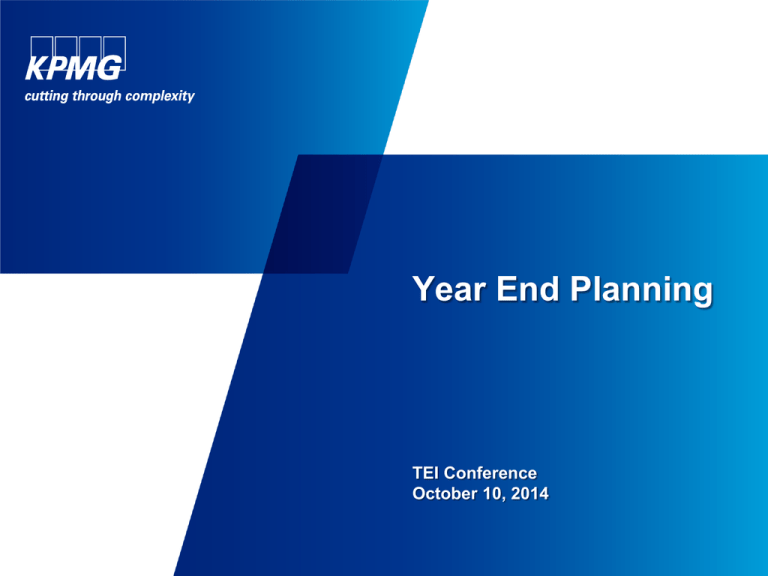
Year End Planning
TEI Conference
October 10, 2014
© 2014 KPMG LLP, a Delaware limited liability partnership and the U.S. member firm of the KPMG network of independent member firms affiliated with KPMG International Cooperative (“KPMG International”), a
Swiss entity. All rights reserved.
Notice
The following information is not intended to be “written advice
concerning one or more Federal tax matters” subject to the
requirements of section 10.37(a)(2) of Treasury Department Circular
230.
You (and your employees, representatives, or agents) may disclose
to any and all persons, without limitation, the tax treatment or tax
structure, or both, of any transaction described in the associated
materials we provide to you, including, but not limited to, any tax
opinions, memoranda, or other tax analyses contained in those
materials.
The information contained herein is of a general nature and based
on authorities that are subject to change. Applicability of the
information to specific situations should be determined through
consultation with your tax adviser.
© 2014 KPMG LLP, a Delaware limited liability partnership and the U.S. member firm of the KPMG network of independent member firms affiliated with KPMG International Cooperative (“KPMG International”), a
Swiss entity. All rights reserved.
2
Today’s presenters
Presenters
Ben Rohrer
Partner, Tax, KPMG
Edward Jankun
Managing Director, Tax, KPMG
Katie LeBlanc
Senior Manager, Tax, KPMG
© 2014 KPMG LLP, a Delaware limited liability partnership and the U.S. member firm of the KPMG network of independent member firms affiliated with KPMG International Cooperative (“KPMG International”), a
Swiss entity. All rights reserved.
Overview
Accounting Methods
− Status report: Tangible property regulations
− Recent developments in:
The tax treatment of research and experimentation costs
Inventory
Capitalization
Section 199
ASC 740 Developments
− SEC Comments on income taxes
− ASU 2013-11: Presentation of UTBs
− EITF Issue 13-B: Accounting for Investments in Qualified
Affordable Housing Projects
− ASU 2014-02: Accounting for Goodwill
© 2014 KPMG LLP, a Delaware limited liability partnership and the U.S. member firm of the KPMG network of independent member firms affiliated with KPMG International Cooperative (“KPMG International”), a
Swiss entity. All rights reserved.
4
Status report: Tangible
property regulations
Long journey to here
January 20, 2004
Notice 2004-6 announces government’s plan to develop tangible property regs
August 21, 2006
Government issues first set of proposed regulations
March 10, 2008
Government withdraws 2006 proposed regulations and issues new proposal
December 27, 2011
2008 proposed regulations withdrawn and replaced with third proposal (also
issued as temporary regulations, so effective immediately)
September 19, 2013
Final regulations published for acquisition costs and for repair and
maintenance costs; proposed regulations issued for dispositions
January 24, 2014
Rev. Proc. 2014-16 issued (repair and maintenance)
February 28, 2014
Rev. Proc. 2014-17 issued (dispositions)
August 14, 2014
Final regulations published for dispositions
September 18, 2014
Rev. Proc. 2014-54 issued modifying Rev. Proc. 2014-17
Ongoing
Industry guidance
© 2014 KPMG LLP, a Delaware limited liability partnership and the U.S. member firm of the KPMG network of independent member firms affiliated with KPMG International Cooperative (“KPMG International”), a
Swiss entity. All rights reserved.
The final regulations
Final Regulations issued September 13, 2013
− Effective for tax years beginning on or after January 1, 2014
− Either final or temporary regulations, or prior standards, may be used for 2012 and
2013 tax years
Organization of regulations – three “buckets”
− Acquisition costs
De minimis rule and materials and supplies standards
− Repair and maintenance costs
Capitalization standards and unit of property definitions
− Dispositions
Partial dispositions provide similar treatment regardless of GAA election
Industry specific guidance
− Pending guidance for cable TV, pipelines, and retailers, and now for restaurants and
mining
© 2014 KPMG LLP, a Delaware limited liability partnership and the U.S. member firm of the KPMG network of independent member firms affiliated with KPMG International Cooperative (“KPMG International”), a
Swiss entity. All rights reserved.
Summary of significant items
Acquisition Costs
− $5000 per item book-conformity safe harbor
− Materials and supplies definition includes under $200 items
− Focus on facilitative and inherently facilitative costs
Repair and Maintenance Costs
− Election to follow book capitalization policy
− Routine maintenance safe harbor
Includes buildings (with a 10-year testing period)
Network assets ineligible (pipelines)
− Casualty losses permitted in conjunction with restorations
− Treatment of removal costs clarified
Dispositions/GAAs
− Disposition rules significantly modified
− Losses allowable for MACRS partial dispositions but generally not permitted for GAAs
© 2014 KPMG LLP, a Delaware limited liability partnership and the U.S. member firm of the KPMG network of independent member firms affiliated with KPMG International Cooperative (“KPMG International”), a
Swiss entity. All rights reserved.
Rev. Proc. 2014-16: Repair and maintenance
Provides method change procedures relating to the final regulations for acquisition costs and
for repair and maintenance costs
−
Generally effective for Forms 3115 filed on or after January 24, 2014
−
Condenses many of the method changes listed in earlier transition guidance
Basic procedures are consistent with other transition guidance
−
Automatic consent granted for covered changes
−
“Scope limitations” waived temporarily (tax years beginning before 2015)
−
After expiration of scope limitation waiver, changes will still be eligible for automatic consent, but
scope limitations will apply (i.e., if under exam must consider window periods; only one
automatic change within a 5 year period; etc.)
Additional requirements
−
The authority for each change must be described in the Form 3115
−
The unit of property for each change must be described in the Form 3115
Section 263A
−
No requirement that 263A methods be in compliance to file an automatic change
−
Must consider 263A in calculating the 481(a) adjustment
−
Adds additional changes under 263A to the automatic consent procedures
© 2014 KPMG LLP, a Delaware limited liability partnership and the U.S. member firm of the KPMG network of independent member firms affiliated with KPMG International Cooperative (“KPMG International”), a
Swiss entity. All rights reserved.
Rev. Proc. 2014-54: Dispositions
Provides method change procedures relating to the temporary and proposed disposition
regulations
−
Generally effective for Forms 3115 filed on or after September 18, 2014
−
Applies to changes to conform to the final disposition regulations
Highlights
−
Applying the disposition regulations to complete or partial dispositions of property not held in a
general asset account (“GAA”).
−
Recovering the remaining basis of property previously disposed of that is continuing to be
depreciated
−
Revoking most GAA elections made under earlier versions of the disposition regulations
−
How to identify disposed assets
−
How to group assets
−
File concurrent method changes to clean up other depreciation methods
−
Clarify interaction of disposition regulations with 280B
Basic procedures are consistent with other transition guidance
−
Automatic consent granted for covered changes
−
“Scope limitations” waived for tax years beginning before 2015
© 2014 KPMG LLP, a Delaware limited liability partnership and the U.S. member firm of the KPMG network of independent member firms affiliated with KPMG International Cooperative (“KPMG International”), a
Swiss entity. All rights reserved.
Recent developments in
the tax treatment of
research and
experimentation costs
Final Section 174 regulations (TD 9680)
TD 9680 was published in the Federal Register on July 21, 2014 and its section 174
regulations are effective for tax years ending on or after that date. Taxpayers may apply
the final regulations to tax years for which the limitations period for the assessment of
tax has not expired. [Taxpayers had earlier been assured that the IRS would not
challenge return positions consistent with the proposed regulations in tax years prior to
the publication of final regulations.]
TD 9680 has many significant provisions, including:
− The ultimate success, failure, sale, or use of the product is not relevant to a determination
of eligibility under section 174.
− The term product includes any pilot model, process, formula, invention, technique, patent,
or similar property, and includes products to be used by the taxpayer in its trade or
business as well as products to be held for sale, lease, or license.
− The IRS and Treasury also note in the preamble that they believe that the current
regulations are sufficiently broad to include indirect or ancillary supplies for section 174.
− In response to other concerns, and to avoid confusion between the section 174
requirements and the requirements of the shrinking-back rule under the section 41
regulations, the final regulations drop the term “shrinking back rule” and eliminate
references to section 41.
© 2014 KPMG LLP, a Delaware limited liability partnership and the U.S. member firm of the KPMG network of independent member firms affiliated with KPMG International Cooperative (“KPMG International”), a
Swiss entity. All rights reserved.
Legislative outlook
Research credit – currently expired as of December 31,
2013
− Bipartisan support for a retroactive extension
− An extension will be the 16th since 1981
− President Obama’s FY 2015 budget proposed a permanent
credit
Legislative vehicles for an extension of the research credit
include:
− The American Research and Competitiveness Act of 2014
(H.R. 4438)
− The Expiring Provisions Improvement, Reform and Efficiency
(“EXPIRE”) Act (S. 2260)
− Camp “Tax Reform Act of 2014” Discussion Draft released
February 26, 2014
© 2014 KPMG LLP, a Delaware limited liability partnership and the U.S. member firm of the KPMG network of independent member firms affiliated with KPMG International Cooperative (“KPMG International”), a
Swiss entity. All rights reserved.
Final and temporary section 41 regulations regarding
alternative simplified credit elections (TD 9666)
On June 3, 2014, the Treasury Department and IRS
published in the Federal Register temporary regulations
(TD 9666) and, by cross-reference, proposed regulations
(REG-133495-13) relating to the alternative simplified credit
(“ASC”) election for purposes of the research credit that is
available under section 41(c)(5).
− The regulations revise the rules for making the ASC election
and allow the election on an amended return if a return
claiming the credit has not previously been filed for that tax
year and if the taxpayer makes the election before the period
of limitations for assessment of tax has expired for that year.
− These regulations do not change the ability to claim a
reduced credit under section 280C, as that election must still
be made on a timely filed original return (including
extensions).
© 2014 KPMG LLP, a Delaware limited liability partnership and the U.S. member firm of the KPMG network of independent member firms affiliated with KPMG International Cooperative (“KPMG International”), a
Swiss entity. All rights reserved.
CCA 201423023 regarding applicable rules for
internal-use software and the FedEx case
On June 6, 2014 an IRS Chief Counsel Advice (“CCA”) number
201423023, dated May 29, 2014, was published.
− CCA 201423023 discusses the IRS Chief Counsel’s Office position on
the innovation standard that must be satisfied to claim a research credit
for internal-use software, in light of the litigation in FedEx Corporation v.
U.S.
− Specifically, CCA 201423023 notes the FedEx decision, holding that the
earlier “discovery test” could not be enforced, and states: “it is
inappropriate for the IRS to challenge taxpayers who apply the general
eligibility provisions of 2004 Final Regulations (TD 9140) . [emphasis
added]” It also advises, consistent with the FedEx decision, “[The IRS]
should not challenge taxpayers that choose . . . to follow only the internal
use software provisions of section 1.41-4(c)(6) in either the January 2001
Final Regulations (TD 8930) or the December 2001 Proposed
Regulations, and [also] follow January 2004 Final Regulations for the
general eligibility rules for qualified research.”
© 2014 KPMG LLP, a Delaware limited liability partnership and the U.S. member firm of the KPMG network of independent member firms affiliated with KPMG International Cooperative (“KPMG International”), a
Swiss entity. All rights reserved.
Other developments
Shami v. Commissioner, 741 F3d 560 (5th Cir. 2014)
− Certain wages paid by an S corporation cosmetics company to its shareholders, the CEO
and the marketing chief, were not qualified expenses for purposes of the research credit.
Geosyntec Consultants, Inc. v. U.S., 2013-2 USTC 50498 (USDC SDFL 2013)
− Amounts that Geosyntec received under fixed price contracts were not funded research
but that amounts it received under cost plus subject to a maximum contracts (“capped”)
contracts were funded research.
− The decision is being appealed.
− This is a very factually intensive area and need to look at the totality of circumstances,
e.g., payments terms and mechanisms / cost overruns provisions; warranty & default
clauses; substantial rights.
Trinity Industries v. U.S., 2014-2 U.S.T.C. ¶50,346, (5th Cir. 2014)
− Key focus is consistency between current year QRE and base year QRE.
− When base year information using the regular research credit may not be readily
available, may consider using the ASC method of calculation.
© 2014 KPMG LLP, a Delaware limited liability partnership and the U.S. member firm of the KPMG network of independent member firms affiliated with KPMG International Cooperative (“KPMG International”), a
Swiss entity. All rights reserved.
Recent developments in
inventory
Final regulations for sales-based royalties
(Section 263A)
Historic area of controversy
− Taxpayer assertion: royalty attaches upon sale, thus not capitalizable.
− IRS assertion: timing of royalty liability does not affect requirement to
capitalize.
Final regulations
− Sales-based royalties that directly benefit or are incurred by reason of
production or resale activities are capitalizable, but only to cost of
goods sold (COGS)
The allocation of sales-based royalties to property sold is optional rather than
mandatory.
The final regulations permit taxpayers to either (1) allocate sales-based
royalties entirely to property sold and include those costs in cost of goods sold
or (2) allocate sales-based royalties between cost of goods sold and ending
inventory using a facts-and-circumstances cost allocation method or a simplified
method.
Sales-based royalties allocated entirely to inventory property sold are included
in cost of goods sold and may not be included in determining the cost of goods
on hand at the end of the tax year regardless of the taxpayer’s cost flow
assumption.
© 2014 KPMG LLP, a Delaware limited liability partnership and the U.S. member firm of the KPMG network of independent member firms affiliated with KPMG International Cooperative (“KPMG International”), a
Swiss entity. All rights reserved.
Final regulations for sales-based vendor
allowances
Narrows definition of sales-based vendor allowances
to sales-based vendor chargebacks
− A sales-based vendor chargeback is an allowance,
discount, or price rebate that a taxpayer becomes
unconditionally entitled to by selling a vendor’s
merchandise to specific customers identified by the
vendor at a price determined by vendor.
− Like sales-based royalties, sales-based vendor
allowances are an adjustment to the cost of the
merchandise sold or deemed sold under the taxpayer’s
cost flow assumption.
© 2014 KPMG LLP, a Delaware limited liability partnership and the U.S. member firm of the KPMG network of independent member firms affiliated with KPMG International Cooperative (“KPMG International”), a
Swiss entity. All rights reserved.
Rev. Proc. 2014-33
Provides procedural guidance for method changes related to sales-based
royalties and sales-based vendor chargebacks under final regulations
− Three new automatic changes added to Rev. Proc. 2011-14:
Change to capitalize sales-based royalties and allocate entirely to COGS, or
change to capitalize sales-based royalties and allocate between COGS and
ending inventory
Change to remove adjustments for sales-based vendor chargebacks from
absorption ratio for taxpayers on simplified section 263A methods
Change to treat sales-based vendor chargebacks as a reduction to COGS
− Applies to tax years ending on or after January 13, 2014
− Method changes may be filed concurrently with other automatic section 263A
changes
− Certain scope limitations waived
© 2014 KPMG LLP, a Delaware limited liability partnership and the U.S. member firm of the KPMG network of independent member firms affiliated with KPMG International Cooperative (“KPMG International”), a
Swiss entity. All rights reserved.
Recent developments in
Section 199
Co-operative advertising
GLAM 2014-001
− Taxpayer is a retailer that produces advertising flyers and receives co-operative
advertising allowances from vendors for placement in the advertisements
− Taxpayer has various agreements with its vendors:
Direct payments from vendor to taxpayer
Reduction of amount owed by taxpayer to vendor for prior purchases
Issuance of credit to taxpayer for future purchases
− If purpose of allowance is contingent upon performance of advertising services, it is
treated as a separate item of gross income (and therefore may potentially qualify as
DPGR)
Facts and circumstances-based determination
© 2014 KPMG LLP, a Delaware limited liability partnership and the U.S. member firm of the KPMG network of independent member firms affiliated with KPMG International Cooperative (“KPMG International”), a
Swiss entity. All rights reserved.
ASC 740 Developments
SEC Comments on
Income Taxes
24
SEC Comments on Income Taxes
2013 AICPA National Conference
At the 2013 AICPA National Conference on Current SEC and
PCAOB Developments, representatives of the SEC indicated:
− With respect to the rate reconciliation, the Staff recommended to:
Clearly label items within the rate reconciliation and disclose the
underlying nature of material reconciling items;
Disclose each material foreign jurisdiction, its associated tax rate, and
the amount of tax when there are material reconciling items;
Do not aggregate or offset material reconciling items;
Ensure consistency of reconciling items disclosed in the rate
reconciliation with amounts reported elsewhere in the filing; and
Evaluate whether adjustments presented as changes in estimates are
better characterized as an error
− Panelists in one session recommended:
Companies have ICFR that monitors both tax law changes and court
rulings
© 2014 KPMG LLP, a Delaware limited liability partnership and the U.S. member firm of the KPMG network of independent member firms affiliated with KPMG International Cooperative (“KPMG International”), a
Swiss entity. All rights reserved.
SEC Comments on Income Taxes
2013 AICPA National Conference (Continued)
At the 2013 AICPA National Conference on Current SEC and PCAOB
Developments, representatives of the SEC indicated:
− With respect to valuation allowances, the Staff:
Cautioned registrants about the use of boilerplate disclosures
For example, registrants often disclose that they considered the four
sources of income. A better disclosure would provide the relative
magnitude of each source of taxable income, as was as an evaluation of
the negative evidence
In instances where registrants have either initially recognized or reversed
an existing valuation allowance, the Staff is likely to question the timing
and judgments involved, particularly the key changes in the registrant's
circumstance from previous periods
− With respect to indefinitely reinvested foreign earnings, the Staff
indicated:
All evidence should be considered when registrants assert that unrepatriated earnings will be indefinitely reinvested, particularly the parent’s
liquidity needs
The Staff frequently identifies omitted disclosures, such as the cumulative
amount of indefinitely reinvested earnings and the unrecognized deferred
tax liability
© 2014 KPMG LLP, a Delaware limited liability partnership and the U.S. member firm of the KPMG network of independent member firms affiliated with KPMG International Cooperative (“KPMG International”), a
Swiss entity. All rights reserved.
ASU 2013-11: Presentation of
an Unrecognized Tax Benefit
When a Net Operating Loss
Carryforward, a Similar Tax
Loss, or a Tax Credit
Carryforward Exists
27
ASU 2013-11—Income Taxes (Topic 740): Presentation of an
Unrecognized Tax Benefit When a Net Operating Loss Carryforward,
a Similar Tax Loss, or a Tax Credit Carryforward Exists
ASU 2013-11 impacts all entities that have
unrecognized tax benefits when a net operating loss
carryforward, similar tax loss or tax credit
carryforward exists at the reporting date
The disallowance of a tax position does not always
result in a cash payment
− Cash payment is not required if sufficient tax attributes
are available and the tax law permits their use to settle
taxes otherwise payable
© 2014 KPMG LLP, a Delaware limited liability partnership and the U.S. member firm of the KPMG network of independent member firms affiliated with KPMG International Cooperative (“KPMG International”), a
Swiss entity. All rights reserved.
28
ASU 2013-11—Income Taxes (Topic 740): Presentation of an
Unrecognized Tax Benefit When a Net Operating Loss Carryforward,
a Similar Tax Loss, or a Tax Credit Carryforward Exists (Cont’d)
Except as noted as follows, an unrecognized tax benefit, or
portion thereof, shall be presented in the financial
statements as a reduction to a DTA for an operating loss,
similar tax loss or tax credit carryforward
Unrecognized tax benefits shall be presented as a liability
to the extent:
− The carryforward is not available at the reporting date to settle any
additional income taxes , or
− The tax law does not require the use, and the entity does not intend
to use, the deferred tax asset for such purpose
The assessment of whether a deferred tax asset is available
is based on the unrecognized tax benefit and deferred tax
asset that exist at the reporting date and shall be made
presuming disallowance of the tax position at the reporting
date
© 2014 KPMG LLP, a Delaware limited liability partnership and the U.S. member firm of the KPMG network of independent member firms affiliated with KPMG International Cooperative (“KPMG International”), a
Swiss entity. All rights reserved.
29
ASU 2013-11—Income Taxes (Topic 740): Presentation of an
Unrecognized Tax Benefit When a Net Operating Loss Carryforward,
a Similar Tax Loss, or a Tax Credit Carryforward Exists (Cont’d)
An unrecognized tax benefit presented as a liability shall
not be classified as a deferred tax liability unless it arises
from a taxable temporary difference
We believe it would be appropriate to present an
unrecognized tax benefit as a reduction of an amount
refundable when there is a legally enforceable right of
setoff and the parties intend to setoff
© 2014 KPMG LLP, a Delaware limited liability partnership and the U.S. member firm of the KPMG network of independent member firms affiliated with KPMG International Cooperative (“KPMG International”), a
Swiss entity. All rights reserved.
30
ASU 2013-11—Income Taxes (Topic 740): Presentation of an
Unrecognized Tax Benefit When a Net Operating Loss Carryforward,
a Similar Tax Loss, or a Tax Credit Carryforward Exists (Cont’d)
We do not believe that taxable income that would result
from the assumed disallowance of a tax position can be
used to support realization of an excess tax deduction
− The increase in taxes payable related to the unrelated tax position
should be established through an increase to tax expense from
continuing operations (or as determined pursuant to the intraperiod
guidance)
− Recognize the benefit of carryforwards related to excess tax
deductions at the time a reduction of income taxes payable occurs
− No interest would be accrued on the related liability to the extent
the excess tax deduction carryforwards would be utilized to settle
additional income taxes
© 2014 KPMG LLP, a Delaware limited liability partnership and the U.S. member firm of the KPMG network of independent member firms affiliated with KPMG International Cooperative (“KPMG International”), a
Swiss entity. All rights reserved.
31
ASU 2013-11
Effective Date and Transition
Entities other than Nonpublic Entities: Fiscal years,
and interim periods within such years, beginning after
December 15, 2013
Nonpublic Entities: Fiscal years, and interim periods
within such years, beginning after December 15, 2014
Application prospective to all unrecognized tax
benefits which exist as of the transition date
Retrospective application permitted
Early adoption permitted
© 2014 KPMG LLP, a Delaware limited liability partnership and the U.S. member firm of the KPMG network of independent member firms affiliated with KPMG International Cooperative (“KPMG International”), a
Swiss entity. All rights reserved.
32
ASU 2013-11
Reporting and Disclosure
Disclosure of the impact that recently issued accounting
standards will have on the financial statements of the
Registrant when adopted in a future period (SAB 74)
− Brief description of the new standard, the date adoption is required
and the date the registrant plans to adopt (if earlier)
− Discussion of the methods of adoption allowed by the standard and
the method expected to be utilized by the registrant, if determined
− Discussion of the impact of adoption or a statement that it is not
known or reasonably estimable
No additional disclosures are required including no
changes to existing disclosure requirements in accordance
with ASC 740-10-50-15A
© 2014 KPMG LLP, a Delaware limited liability partnership and the U.S. member firm of the KPMG network of independent member firms affiliated with KPMG International Cooperative (“KPMG International”), a
Swiss entity. All rights reserved.
33
ASU 2013-11
Reporting and Disclosure (Cont’d)
An entity should disclose the following in the fiscal
period in which a change in accounting principle is
made:
− The nature of and reason for the change in accounting principle
− A description of the prior-period information that has been
retrospectively adjusted, if any
− The effect of the change on any affected financial statement line
item for the current period and any prior periods retrospectively
adjusted
An entity that issues interim financial statements shall
provide the required disclosures in the financial
statements of both the interim period of the change
and the annual period of the change
© 2014 KPMG LLP, a Delaware limited liability partnership and the U.S. member firm of the KPMG network of independent member firms affiliated with KPMG International Cooperative (“KPMG International”), a
Swiss entity. All rights reserved.
34
ASU 2013-11
Example 1
Facts:
Corporation D begins 2012 with a deferred tax asset for a $1,000
NOL carryforward that is offset by a full valuation allowance
Corporation D reports $200 of taxable income on its 2012 tax
return inclusive of a tax position that reduced total taxable
income by $100
The $100 tax position is not more likely than not of being
sustained if challenged by the taxing authority
Assume a 40% tax rate, ignore AMT and assume that Corporation
D has adopted ASU 2013-11
Question:
How would the UTB associated with the $100 tax position be
presented?
© 2014 KPMG LLP, a Delaware limited liability partnership and the U.S. member firm of the KPMG network of independent member firms affiliated with KPMG International Cooperative (“KPMG International”), a
Swiss entity. All rights reserved.
35
ASU 2013-11
Example 1 Solution
The $40 UTB would be presented as a reduction to the deferred
tax asset for the NOL carryforward with no impact to income
taxes payable
If Corporation D concluded it needed to maintain a valuation
allowance at the end of 2012, a valuation allowance of $280 ($700
remaining NOL carryforward at 40%) would be recognized
Corporation D would disclose a $40 UTB associated with the $100
tax position pursuant to ASC 740-10-50-15A(a) and (b) in 2012
© 2014 KPMG LLP, a Delaware limited liability partnership and the U.S. member firm of the KPMG network of independent member firms affiliated with KPMG International Cooperative (“KPMG International”), a
Swiss entity. All rights reserved.
36
ASU 2013-11
Example 2
Facts:
Assume the same facts in Example 1
Corporation D reports $740 of taxable income on its 2013
tax return
The $100 tax position continues to not be more likely than
not of being sustained if challenged by the taxing authority,
but has not been assessed as of 2013
Assume a 40% tax rate, ignore AMT and assume that
Corporation D has adopted ASU 2013-11
Question:
How would the UTB associated with the $100 tax position
be presented?
© 2014 KPMG LLP, a Delaware limited liability partnership and the U.S. member firm of the KPMG network of independent member firms affiliated with KPMG International Cooperative (“KPMG International”), a
Swiss entity. All rights reserved.
37
ASU 2013-11
Example 2 Solution
The $40 UTB would be presented as a reduction to the deferred
tax asset for the NOL carryforward to the extent an available
carryforward exists as of the reporting date; however, due to the
taxable income incurred during 2013, only $60 of available NOL
carryforward exists ($800 - $740) on the tax returns as filed
The disallowance of the UTB would reflect a reduction to the
deferred tax asset for the NOL carryforward of $24 and an
increase to income taxes payable of $16
As such, $0 of DTA related to the NOL carryforward and $16 of
income taxes payable would be presented on the 2013 balance
sheet
Corporation D would continue to disclose a $40 UTB associated
with the $100 tax position pursuant to ASC 740-10-50-15A(a) and
(b) in 2013
© 2014 KPMG LLP, a Delaware limited liability partnership and the U.S. member firm of the KPMG network of independent member firms affiliated with KPMG International Cooperative (“KPMG International”), a
Swiss entity. All rights reserved.
38
ASU 2013-11
Example 3
Facts:
Corporation F is a German entity and begins 2012 with a deferred tax
asset for a $1,000 NOL carryforward that is offset by a full valuation
allowance
Corporation F reports $200 of taxable income on its 2012 tax return
inclusive of a tax position that reduced total taxable income by $100
The $100 tax position is not more likely than not of being sustained if
challenged by the taxing authority
German tax law provides that an NOL may only offset 60% of taxable
income
Assume a 30% tax rate and assume that Corporation F has adopted
ASU 2013-11
Question:
How would the UTB associated with the $100 tax position be
presented?
© 2014 KPMG LLP, a Delaware limited liability partnership and the U.S. member firm of the KPMG network of independent member firms affiliated with KPMG International Cooperative (“KPMG International”), a
Swiss entity. All rights reserved.
39
ASU 2013-11
Example 3 Solution
The $30 UTB would be presented as a partial reduction of
$18 to the deferred tax asset for the NOL carryforward and
an increase of $12 to income taxes payable
If Corporation F concluded it needed to maintain a
valuation allowance at the end of 2012, a valuation
allowance of $246 ($820 remaining NOL carryforward at
30%) would be recognized
Corporation F would disclose a $30 UTB associated with
the $100 tax position pursuant to ASC 740-10-50-15A(a) and
(b) in 2012
© 2014 KPMG LLP, a Delaware limited liability partnership and the U.S. member firm of the KPMG network of independent member firms affiliated with KPMG International Cooperative (“KPMG International”), a
Swiss entity. All rights reserved.
40
ASU 2013-11
Example 4
Facts:
Corporation G reports $200 of taxable income on its 2012 tax return
inclusive of a tax position that reduced total taxable income by $100
The $100 tax position is not more likely than not of being sustained if
challenged by the taxing authority
Corporation G has a 40% tax rate and paid $80 of tax with its 2012
return and reflected a liability of $40 for an unrecognized tax benefit
During 2015, Corporation G made a deposit with the taxing authority
of $40 and although the deposit is not related to a specific tax
position, the terms dictate that it will be forfeited if the tax position is
disallowed, rather than making an additional payment to the taxing
authority
Question:
How would the UTB associated with the $100 tax position be
presented in the 2015 balance sheet?
© 2014 KPMG LLP, a Delaware limited liability partnership and the U.S. member firm of the KPMG network of independent member firms affiliated with KPMG International Cooperative (“KPMG International”), a
Swiss entity. All rights reserved.
41
ASU 2013-11
Example 4 Solution
The $40 UTB would be presented as a reduction to the
income tax receivable for the deposit resulting in a zero
balance
No liability for income taxes payable related to the tax
position would be recognized
Corporation G would continue to disclose a $40 UTB
associated with the $100 tax position pursuant to ASC 74010-50-15A(a) and (b) in 2015
© 2014 KPMG LLP, a Delaware limited liability partnership and the U.S. member firm of the KPMG network of independent member firms affiliated with KPMG International Cooperative (“KPMG International”), a
Swiss entity. All rights reserved.
42
ASU 2013-11
Example 5
Facts:
Corporation H begins 2012 with a $1,000 NOL carryforward that is
entirely related to excess tax deductions on share-based
compensation
Corporation H reports $200 of taxable income on its 2012 tax return
inclusive of a tax position that reduced total taxable income by $100
related to litigation settlements for which there is uncertainty as to
whether they represent non-deductible penalties
The $100 tax position is not MLTN of being sustained if challenged
by the taxing authority
Assume a 40% tax rate and ignore AMT
Question:
How would the UTB associated with the $100 litigation settlement tax
position be presented?
© 2014 KPMG LLP, a Delaware limited liability partnership and the U.S. member firm of the KPMG network of independent member firms affiliated with KPMG International Cooperative (“KPMG International”), a
Swiss entity. All rights reserved.
43
ASU 2013-11
Example 5 Solution
If the tax position were disallowed, Corporation H would not
make a payment to the taxing authority and instead would
forfeit $100 of its NOL carryforward
Taxable income that would result from the assumed
disallowance of a tax position is not believed to support
“realization” of an excess tax benefit
Corporation H would recognize current income tax expense
of $120 ($300 x 40%) in continuing operations, a tax benefit
of $80 ($200 x 40%) in additional paid-in capital for the
portion of the excess tax benefit NOLs that were realized
and an income tax liability of $40 for the UTB
Interest would not be accrued on the liability since a
payment would not be required upon disallowance
© 2014 KPMG LLP, a Delaware limited liability partnership and the U.S. member firm of the KPMG network of independent member firms affiliated with KPMG International Cooperative (“KPMG International”), a
Swiss entity. All rights reserved.
44
ASC Subtopic 323-740
Accounting for
Investments in
Qualified Affordable
Housing Projects
45
Background
Low Income Housing Tax Credit (LIHTC or Affordable Housing Tax Credit):
•
Designed to encourage investment in the construction and rehabilitation of low
income housing.
•
Tax credits are available to investors in limited liability entities that own qualified
affordable housing projects (property entities).
LIHTC Investment Considerations:
•
The property entities typically generate (and
pass on) tax benefits in the form of tax credits
and pre-tax losses when considering the
effects of depreciation.
•
Investors expect a positive return on
investment when considering the tax credits
and the tax benefits from the pass-through of
pre-tax operating losses.
© 2014 KPMG LLP, a Delaware limited liability partnership and the U.S. member firm of the KPMG network of independent member firms affiliated with KPMG International Cooperative (“KPMG International”), a
Swiss entity. All rights reserved.
Background (continued)
ASC Subtopic 323-740 (previously EITF Issue No. 94-1,
Accounting for Tax Benefits Resulting from Investments
in Affordable Housing Projects) allows an investor to
apply the effective yield if:
Availability of tax credits is guaranteed by a third party,
Projected yield based solely on cash flow from tax credits is
positive, AND
It is a limited partner in the project with liability limited to its
capital investment.
© 2014 KPMG LLP, a Delaware limited liability partnership and the U.S. member firm of the KPMG network of independent member firms affiliated with KPMG International Cooperative (“KPMG International”), a
Swiss entity. All rights reserved.
Why Revisit LIHTC Investments?
Criteria in EITF 94-1
IfIfNot
Met
Not Met
IfIf Met
Met
• May apply the “effective yield method”
whereby the tax benefits are combined
with the amortization of the investment in
order to achieve a constant effective yield
over the life of the investment.
• Both the amortization of the investment
and the tax benefits are recorded in
income tax expense.
• Apply either the equity or cost method in
accordance with ASC 970-323 (previously
SOP 78-9), Investments—Equity Method
and Joint Ventures.
• Amortization of investment (modified cost
method) or equity method losses are
recorded in pre-tax income
• Tax credits (and other tax benefits) are
recorded separately in income tax
expense.
Criteria rarely met in practice
© 2014 KPMG LLP, a Delaware limited liability partnership and the U.S. member firm of the KPMG network of independent member firms affiliated with KPMG International Cooperative (“KPMG International”), a
Swiss entity. All rights reserved.
Why Revisit LIHTC Investments (continued)
The EITF reached a final consensus, which was endorsed by the FASB to:
• Allow companies that meet certain criteria to apply a proportional amortization
method to account for LIHTC investments.
• Companies may also use a practical expedient to amortize the investment.
• Amortization of the cost of the investment would be recognized in proportion to
and over the same period as the recognition of the tax credits and other tax
benefits.
• The amortization of the investment would be included in income tax expense.
• Impairment would be recognized if it was more likely than not that the carrying
amount of the investment would not be realized.
• If the investment does not qualify for the proportional amortization method, or
the company does not elect to use it, the investment would be accounted for under
the equity or cost method based on existing GAAP.
© 2014 KPMG LLP, a Delaware limited liability partnership and the U.S. member firm of the KPMG network of independent member firms affiliated with KPMG International Cooperative (“KPMG International”), a
Swiss entity. All rights reserved.
Other Considerations
Ongoing
Qualification
• Change in the investment
• Change in the relationship that
could result in the investment not
meeting the criteria
Impairment of
the Investment
• More likely than not that the
carrying amount of the investment
will not be realized
Effective Tax
Rate and
Interim Periods
• All components related to the investment will
be considered permanent items
• Net impact on income tax expense should be
considered when estimating the annual
effective tax rate used for interim reporting
© 2014 KPMG LLP, a Delaware limited liability partnership and the U.S. member firm of the KPMG network of independent member firms affiliated with KPMG International Cooperative (“KPMG International”), a
Swiss entity. All rights reserved.
Other Considerations (continued)
Disclosure
Requirements
• Enable users to understand the nature of
all LIHTC investments and the effect of
investments on the balance sheet and
income statement
• Suggested disclosures provided
Effective Date
• For public business entities, annual and
interim periods beginning after December
15, 2014. For other entities, annual
periods beginning after December 15,
2014 and interim periods thereafter.
Transition
• Retrospective application required
• Elimination of existing deferred taxes at
transition
• Continuation of the effective yield method for
existing investments
• Early adoption permitted
© 2014 KPMG LLP, a Delaware limited liability partnership and the U.S. member firm of the KPMG network of independent member firms affiliated with KPMG International Cooperative (“KPMG International”), a
Swiss entity. All rights reserved.
Other Considerations (continued)
Other Tax
Credits
• The Task Force reached a consensus to issue an Exposure
Draft to expand the use of the proportional amortization
method to other tax credits.
• The FASB did not endorse the Exposure Draft.
• The FASB recently added to its agenda government
assistance programs
• The focus of the agenda item is on disclosure only.
© 2014 KPMG LLP, a Delaware limited liability partnership and the U.S. member firm of the KPMG network of independent member firms affiliated with KPMG International Cooperative (“KPMG International”), a
Swiss entity. All rights reserved.
ASU 2014-02: Accounting
for Goodwill
(A Consensus of the
Private Company Council)
53
ASU 2014-02: Accounting for Goodwill
Summary
If elected, ASU 2014-02 provides an accounting alternative
under U.S. GAAP in which goodwill is amortized on a
straight-line basis over ten years, or less than ten years if
the entity demonstrates that another useful life is more
appropriate
− Entities electing this standard are required to make an
accounting policy decision to test goodwill for impairment at
either the entity level or the reporting unit level
− Tested for impairment when a triggering event occurs that
indicates that the fair value of an entity (or a reporting unit)
may be below its carrying amount
− Measurement of goodwill impairment would be the difference
between the fair value of the entity (or reporting unit) and its
carrying amount
© 2014 KPMG LLP, a Delaware limited liability partnership and the U.S. member firm of the KPMG network of independent member firms affiliated with KPMG International Cooperative (“KPMG International”), a
Swiss entity. All rights reserved.
54
ASU 2014-02: Accounting for Goodwill
Effective Date and Transition
The accounting alternative (if elected) should be
applied prospectively to goodwill existing as of the
beginning of the period of adoption and new goodwill
recognized in annual periods beginning after
December 15, 2014, and interim periods within annual
periods beginning after December 15, 2015.
Early application is permitted, including application to
any period for which the entity’s annual or interim
financial statements have not yet been made available
for issuance
© 2014 KPMG LLP, a Delaware limited liability partnership and the U.S. member firm of the KPMG network of independent member firms affiliated with KPMG International Cooperative (“KPMG International”), a
Swiss entity. All rights reserved.
55
ASU 2014-02: Accounting for Goodwill
Accounting for Income Tax Considerations
If an entity chooses to elect ASU 2014-02, the amortization is
reflected in the following manner:
− Component Two Book Goodwill
Amortization is allocated pro-rata amongst Component One and Component
Two book goodwill
• Alternative view would allocate first to Component Two then to Component
One
Component Two goodwill amortization is reflected as a reconciling item within
the rate reconciliation
Remaining Component One goodwill book carrying amount is compared to the
tax carrying balance to determine the taxable or deductible temporary
difference
− Component Two Tax Goodwill
Amortization is allocated entirely to Component One book goodwill
The impact of the book amortization is reflected as an adjustment to the
temporary difference thereby resulting in no reconciling item within the rate
reconciliation
Remaining Component One goodwill book carrying amount is compared to the
tax carrying balance to determine the taxable or deductible temporary
difference
© 2014 KPMG LLP, a Delaware limited liability partnership and the U.S. member firm of the KPMG network of independent member firms affiliated with KPMG International Cooperative (“KPMG International”), a
Swiss entity. All rights reserved.
56
ASU 2014-02: Accounting for Goodwill
Accounting for Changes in Valuation Allowance
If an entity chooses to elect ASU 2014-02, the deferred tax
liability associated with the excess book over tax basis may
no longer have an “indefinite” life
− Consequently, the deferred tax liability may be considered a
source of taxable income in assessing the realizability of
deferred tax assets
Changes in the valuation allowance as a result of applying
ASU 2014-02 is recorded through income from continuing
operations
− We believe that the release of a valuation allowance based
on the consideration of the reversal of a deferred tax liability
should be treated as a change in judgment about the
recoverability of the beginning of year deferred tax assets
due to changes in the expectation of income that would be
generated by the entity in the current and future periods
© 2014 KPMG LLP, a Delaware limited liability partnership and the U.S. member firm of the KPMG network of independent member firms affiliated with KPMG International Cooperative (“KPMG International”), a
Swiss entity. All rights reserved.
57
Example 1: ASU 2014-02 - Accounting for
Goodwill
ABC Company recognized $1M of book goodwill and
$1M of tax goodwill in the taxable asset acquisition of
DEF Company on January 1, 20X2. The tax goodwill is
amortized over 15 years. DEF Company was acquired
primarily for its proprietary technology which has a
remaining useful life of 10 years.
How would ABC Company account for the goodwill
going forward?
Assuming a 40% tax rate, what deferred tax
consequences would be required at December 31,
20X2?
© 2014 KPMG LLP, a Delaware limited liability partnership and the U.S. member firm of the KPMG network of independent member firms affiliated with KPMG International Cooperative (“KPMG International”), a
Swiss entity. All rights reserved.
58
Example 1: ASU 2014-02 - Accounting for
Goodwill (Cont’d)
Under ASU 2014-02, goodwill would be amortized over
a period of 10 years as the primary purpose for the
acquisition was for the proprietary technology
$100K of book amortization expense would be
recorded in the year-ended December 31, 20X2
$67K of tax amortization expense would be recorded in
the year-ended December 31, 20X2
Book
Tax
20X1 Carrying Amount
1,000,000
1,000,000
20X2 Amortization
(100,000)
(66,667)
900,000
933,333
20X2 Carrying Amount
Temp
DTA (DTL)
0
0
33,333
13,333
© 2014 KPMG LLP, a Delaware limited liability partnership and the U.S. member firm of the KPMG network of independent member firms affiliated with KPMG International Cooperative (“KPMG International”), a
Swiss entity. All rights reserved.
59
Example 2: ASU 2014-02 - Accounting for
Goodwill
ABC Company recognized $1M of book and $750K tax
goodwill in the taxable asset acquisition of DEF
Company on January 1, 20X2. The tax goodwill is
amortized over 15 years. DEF Company was acquired
primarily for its proprietary technology which has a
remaining useful life of 10 years.
How would ABC Company account for the goodwill
going forward?
Assuming a 40% tax rate, what deferred tax
consequences would be required at December 31,
20X2?
© 2014 KPMG LLP, a Delaware limited liability partnership and the U.S. member firm of the KPMG network of independent member firms affiliated with KPMG International Cooperative (“KPMG International”), a
Swiss entity. All rights reserved.
60
Example 2: ASU 2014-02 - Accounting for
Goodwill (Cont’d)
As noted in example 1, goodwill is amortized over 10 years
$100K of book amortization expense would be recorded in the
year-ended December 31, 20X2
$50K of tax amortization expense would be recorded in the yearended December 31, 20X2
Component One
Book
Tax
Temp
20X1 Carrying Amount
750,000
750,000
20X2 Amortization
(75,000)
(50,000)
20X2 Carrying Amount
675,000
700,000
Component Two
Book
Tax
DTA (DTL)
0
0
25,000
10,000
Temp
20X1 Carrying Amount
250,000
0
20X2 Amortization
(25,000)
0
20X2 Carrying Amount
225,000
0
DTA (DTL)
(250,000)
0
(225,000)
0
© 2014 KPMG LLP, a Delaware limited liability partnership and the U.S. member firm of the KPMG network of independent member firms affiliated with KPMG International Cooperative (“KPMG International”), a
Swiss entity. All rights reserved.
61


